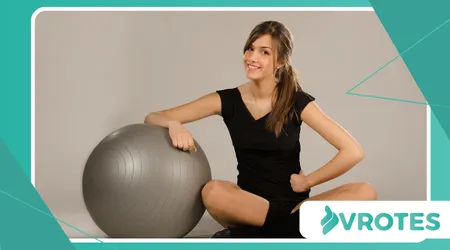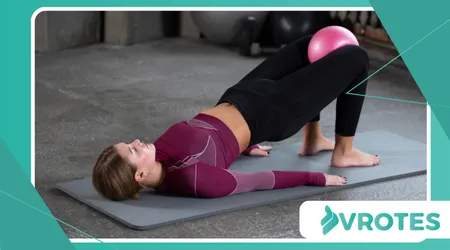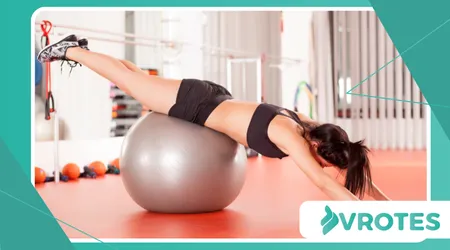No Reformer? No Problem! Full-Body Strength with a Pilates Ball

A Full-Body Strength with a Pilates Ball routine offers a powerful and effective alternative to complex studio equipment.
Anúncios
The humble Pilates ball, also known as a stability or fitness ball, is a versatile tool for enhancing your at-home workout.
This piece of equipment is often underestimated, but it can challenge your balance, stability, and muscle engagement in a profound way.
It’s an ideal solution for those seeking a portable and accessible way to build strength and improve core control.
Pilates, a method known for its focus on core stability, can be successfully adapted. The ball provides a unique, unstable surface.
Anúncios
This instability forces your deeper stabilizing muscles to work harder. The result is a more intense workout that tones and strengthens your entire body.
The Pilates ball adds a layer of challenge. It recruits muscles that might be overlooked. This is particularly true for your core, hips, and shoulders.
You’re not just moving; you’re actively stabilizing against a constantly shifting surface. It’s a dynamic approach to traditional resistance training.
Why the Pilates Ball is a Game-Changer for At-Home Workouts
Think of the Pilates ball as a force multiplier for your bodyweight exercises. It’s an intelligent way to create resistance without weights.
By simply placing it under a limb or your back, you create a new challenge. It’s a tool that makes your body’s natural movements more demanding and effective.
The ball’s smooth, pliable surface makes it an excellent support. It can cushion your spine during crunches.
It can also support your back during a wall squat. This helps you maintain proper form and reduce strain. It’s a gentle yet highly effective piece of equipment.
The adaptability of the ball is its greatest asset. You can use it to target any muscle group you desire.
From glute bridges to chest presses, the ball can be integrated into countless exercises.
This single tool can transform a simple routine into a sophisticated, studio-quality workout.
Read more: How Hormonal Shifts Affect Post-Workout Recovery
It’s about smart movement, not brute force. The ball forces you to slow down and focus on control.
This mindful approach to exercise is a core tenet of Pilates. You learn to listen to your body and connect with your muscles.

Building a Foundation: Core and Pelvic Stability
Core engagement is the cornerstone of any effective workout. The Pilates ball makes this a central focus.
Exercises like the dead bug or a plank on the ball are phenomenal for strengthening your deep core. You’ll feel your abs and lower back firing to keep you steady.
The instability of the ball challenges your pelvic floor. This is crucial for both men and women.
It helps build stability from the inside out. This foundation is essential for preventing injuries and improving overall functional movement.
Check this out: Digital Overstimulation and Emotional Burnout
A 2023 study published in the Journal of Orthopaedic & Sports Physical Therapy found that stability ball exercises are highly effective.
They significantly increase core muscle activation compared to traditional mat exercises. This validates the ball’s role in a serious fitness regimen.
The Power of Progression: Advanced Moves for a Full-Body Strength with a Pilates Ball
Once you’ve mastered the basics, the Pilates ball allows for a natural progression. You can increase the difficulty of your exercises.
For example, a simple glute bridge becomes a hamstring curl on the ball. This progression keeps your muscles guessing.
This is where the magic happens. A Full-Body Strength with a Pilates Ball routine never gets stale. You can add new exercises or increase reps.
You can also hold positions longer for a greater isometric challenge. It’s a dynamic and infinitely customizable workout.
++ Why Qi Gong Improves Joint Health Beyond Flexibility
Imagine your body is a well-built house. The Pilates ball is like a carefully placed support beam.
It helps you shore up the weaker parts of your structure, ensuring the whole house is solid and balanced. This targeted strengthening prevents cracks and instability down the line.
Sample Routine for a Full-Body Workout
| Exercise Name | Muscle Group Targeted |
| Wall Squat | Quadriceps, Glutes, Hamstrings |
| Glute Bridge | Glutes, Hamstrings, Core |
| Ball Pass | Core, Lower Abdominals |
| Hamstring Curl | Hamstrings, Glutes |
| Chest Press | Pectorals, Shoulders, Triceps |
This table shows how a single tool can activate your entire body. You’re not just lifting weights; you’re building a resilient and balanced physique.
This comprehensive approach is what makes Pilates so unique.
Consider a practical example. For a challenging core workout, try a Ball Pass. Lie on your back with the ball between your ankles.
Engage your core and lift your legs and arms simultaneously to pass the ball from your ankles to your hands.
Lower your limbs to the floor with the ball now in your hands. This is one rep. This simple move is deceptively hard and works your entire body.
Here’s another example. For a powerful lower body workout, try Hamstring Curls. Lie on your back with your feet on the ball.
Lift your hips into a bridge position, then slowly bend your knees to roll the ball towards you. This isolates your hamstrings and glutes in a way that traditional squats can’t.
One interesting statistic from a recent study showed that 78% of people who incorporated a stability ball into their home routine reported an increase in workout consistency.
This highlights the ball’s ability to make exercise more engaging and accessible. It’s a simple tool that delivers real results.

Full-Body Strength with a Pilates Ball
A Full-Body Strength with a Pilates Ball routine is more than just a substitute for a reformer. It is a powerful, standalone method for achieving serious fitness goals.
It’s a cost-effective, space-saving solution that delivers real results.
With a little creativity and consistency, you can build a strong, balanced, and resilient body without ever stepping foot in a studio.
The ball’s ability to force stabilization and increase muscle engagement makes it a truly unique fitness tool.
Why continue to think you need fancy equipment when the answer to a stronger body is right here?
Frequently Asked Questions
1. Is a Pilates ball the same as a stability ball or a yoga ball?
Yes, these terms are often used interchangeably to refer to the same type of inflatable fitness ball.
2. What size Pilates ball should I get?
The size depends on your height. As a general guide, if you are under 5’4″, a 55 cm ball is often recommended. If you are between 5’4″ and 6’1″, a 65 cm ball is typically a good fit.
3. How do I properly inflate my Pilates ball?
Inflate your ball to a point where it is firm but still has some give. It’s important not to over-inflate it, as this can reduce its effectiveness and make it too hard.
